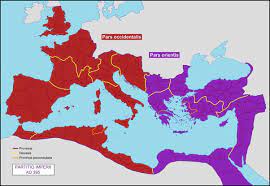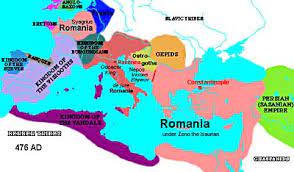Italy: Why did the Roman Empire split in two?

Joe Phelan
Rome: An old adage states that Rome wasn’t built in a day, meaning that big projects take time to complete. The Roman Empire, as an example, was established gradually and grew over hundreds of years from a city-state to a colossal empire stretching from Britain to Egypt.
And just as Rome and its empire wasn’t built in a day, it wasn’t destroyed in one either. For centuries, Rome was the center of the empire, but as Rome’s fortunes changed, the seat of power eventually shifted away from the city, and the empire permanently split into two separate states in A.D. 395 — one in the east, and one in the west. But why did the Roman Empire divide into the Western Roman Empire and Eastern Roman Empire? And did it happen quickly?
In short, the empire’s vast size played a role — its colossal borders made it challenging to govern — but other factors, such as political and social instability, revolts, invasions and incursions into the empire, also led to the split.

It’s easy to think that the Roman Empire fractured because it became too big, but according to Mark Humphries, professor of classics at Swansea University in Wales, “it’s more complicated than that.” Besides its size, the Roman Empire also faced multifaceted problems, such as rival Roman rulers and foreign tribes and empires threatening their borders. Nevertheless, the empire’s size was impressive, and created numerous challenges.
“The Roman Empire was the biggest state western Eurasia has ever seen and, even though it looks big on the map, it was even bigger in practice because of communication speeds,” Peter Heather, professor of medieval history at King’s College London in England, told Live Science in an email. “Over land, it was possible to travel about 20 miles [32 kilometers] a day, whereas now we can go maybe 400 [miles, or 640 km]. Given the real measure of distance is how long it takes a person to cover ground, the Empire was, to all intents and purposes, 20 times bigger than it appears to us today.”
At its height, the Roman Empire covered much of Europe, as well as parts of Africa and Asia. It stretched from the Atlantic Ocean in the west to what is now part of Iraq, Kuwait, Turkey and Syria in the east.
The Roman Empire was, to some extent, a victim of its own success. It became so large that it incorporated many different regions and cultures, and as it grew, so too did its borders. As a result, attacks and unwanted border crossings — predominantly by Goths and other barbarian groups — became more common and more difficult to deal with in an effective and timely manner.
But Heather agreed that its size was not the only factor in the Roman Empire’s split. “Size is not the total explanation, because it was that big from the 1st c. A.D., and we only see a systemic split in the 4th century,” Heather said.
At its height, the Roman Empire’s roads traversed continents to connect important cities and towns to its capital city.
So what else played a part? “In my view, two additional factors compounded the basic problem of distance. The first is the rise of Persia to superpower status in the 3rd century [A.D.], which meant Rome had to have an emperor somewhere close to the Persian frontier,” Heather said. The second is that by the fourth century, the definition of “Roman” had changed to encompass provincial elites all the way from Scotland to Iraq. Many “Romans,” given the scale of the Empire, had little or no affiliation with the city of Rome itself. Splitting the empire, it was thought, would make it easier to oversee these various, very often different, regions and cultures.
The split of the Roman Empire was a long time coming, and divisions had occurred prior to the final, permanent East-West divide in the fourth century, according to Humphries.
“We often think of [the split] happening at one specific point in time. The most common date given is [A.D.] 395, when [Roman emperor] Theodosius I died and was succeeded by his sons Arcadius and Honorius, who became rulers in the East and West respectively,” Humphries said.
“However, the principle of collegiate rulership [having more than one emperor] had been part of the framework of imperial government for more than a century at that point. Diocletian, who became emperor in [A.D.] 284, experimented with various configurations of imperial government.” Diocletian established a tetrarchy, or rule of four, between two senior emperors, or augusti — one in the east and one in the west — and two junior rulers, or caesars.
The tetrarchy fell apart shortly after Diocletian’s abdication in A.D. 305, and after various augusti and caesars battled for power, the empire reunited when Constantine I defeated his co-rulers in A.D. 324. But the empire was again divided upon Constantine’s death, this time among three of his sons.
So, if the Roman Empire was divided far earlier than the oft-quoted 395 date, why do historians pinpoint that year as the time the empire split in two? “I suspect that what happens after 395 is that the division looks more stark in hindsight,” Humphries said.
There was, perhaps, an “over-emphasis on the united-ness of the Empire before 395,” Humphries said, adding that “the idea that Theodosius I was the last ruler of a united Roman Empire is complete nonsense.” For instance, Theodosius “almost always ruled jointly with someone else, even if he chose not always to recognise some of those colleagues as legitimate emperors,” which would indicate that, prior to 395, a “split” was effectively already in place, Humphries said.
So, once the empire split into two, what were relations between the two states like? Did both sides of the empire work closely together and operate as a unified body?
“Not always,” Heather said. “It was very hard to divide the office and maintain good relations between colleagues over the long-term. It was done because it was necessary, but it usually generated tension, and this was an unavoidable problem.” Humphries agreed with Heather’s assertion.
“The ideal was of two parts ruling in harmony,” Humphries said. “Emperors in the East and West issued coins in each other’s names, and there was military assistance sent to the West from the East against the Vandals. That said, there were moments of tension. On occasion, relations could break down,” Humphries said.
“For example, it was often the case that East and West would refuse to recognise the consuls nominated in the other. During the period of Stilicho’s [a powerful and influential Gothic military leader] ascendancy in the West, Eastern appointees to the consulship were not recognised in the West in [A.D.] 399 and 400,” Humphries noted. “This refusal to recognise consuls had been a feature of earlier breakdowns in relations between emperors in different parts of the empire.”
At this point in time, the consulship was, according to Humphries, “an entirely honorific position,” and was generally seen as a reward rather than a high-powered job. To shun a consul, therefore, was to show disdain to an esteemed, often heroic individual.
The Western Empire ultimately collapsed in A.D. 476, when Odoacer — a Germanic leader often referred to as Italy’s first “barbarian king”(opens in new tab) — revolted and overthrew the emperor Romulus Augustulus. This is widely considered to be the end point of the Western Roman Empire.
The Eastern Roman Empire, also known as the Byzantine Empire, survived until 1453, though many historians — Heather included — do not consider this to be part of the “true” Roman Empire.
“I would argue — and I’m not alone in this — that the Byzantine Empire was as much a successor state to the Roman Empire as any of its western counterparts, such as the Visigothic or Frankish kingdoms,” Heather said.





